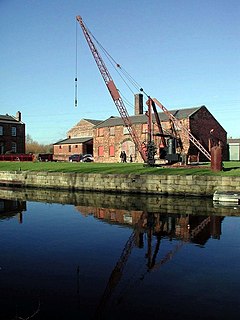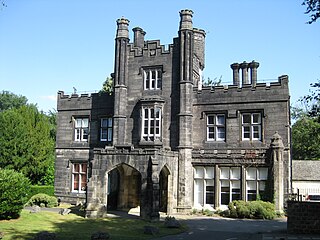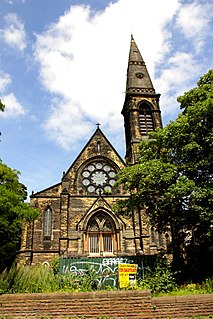
Moorfield House is a Victorian house in Headingley, Leeds, England built between 1855 and 1856 by William Glover Joy. It is now number 11 Alma Road, and is also referred to as Moorfield Court. [1]

Moorfield House is a Victorian house in Headingley, Leeds, England built between 1855 and 1856 by William Glover Joy. It is now number 11 Alma Road, and is also referred to as Moorfield Court. [1]
The house is in Gothic style, built of gritstone and ashlar with slate roofs. It has a three-storey octagonal tower with octagonal corner turrets. The east-facing front facade has a central porch with elaborate carvings including crouching dogs and carved human heads, surmounted by a spire. The interior includes an octagonal chapel and panelled rooms. [1] [2]
The house was built between 1855/56 by William Glover Joy, seed crusher and oil merchant, on land which earlier had belonged to the Earl of Cardigan's estate. Joy had entered his father's business ten years earlier to join a business which was the result of research work pioneered by his grandfather into the production of oil from seeds. The growth of the business was related most strongly to the development of the locomotive age and the local railway network. In 1868 Joy became Mayor of Leeds.
At this time, the house was set in about 10 acres (40,000 m2) of grounds. In 1877 the Joy family moved to Hull and Moorfield House was bought by a Samuel Smith, tanner and currier of Meanwood. In the 1880s the Joy family re-acquired the house but in 1891 sold it to John Carr Nicholson, dry salter and manufacturing chemist.
In 1936 the property was bought by Miss Elsie Thackrah BSc of the White Hart Hotel, Harrogate for £1,650. The house became Moorfield House Missionary College and Miss Thackrah the principal. During the war years the property was taken by the Secretary of State for Air and was probably used by the airforce as wartime administration offices. The Automobile Association obtained the property in 1944 for £4,250. The Association extended the building to the rear and the building was used as regional offices until May 1973.
During 1973 Moorfield House became a Grade II listed building in the Grove Lane/Wood Lane Conservation Area; the listing describes it as being "in Tudor Gothic Castle Style". [2]
In 1979 the property was acquired by architects Fletcher Ross & Hickling to provide centralised facilities for three separate offices and, following extensive refurbishment, the building was occupied by the practice in 1980.
In 1988, Brahm Ltd acquired the land to the side of Moorfield House and built a single storey office. Due to expansion, Brahm purchased Moorfield House from Fletcher Ross & Hickling in 1995 and connected the two buildings. Following a rebrand in 2010, both buildings are now occupied by the Brass Agency.

Headingley is a suburb of Leeds, West Yorkshire, England, approximately two miles out of the city centre, to the north west along the A660 road. Headingley is the location of the Beckett Park campus of Leeds Beckett University and Headingley Stadium.

Meanwood is a suburb and former village in north-east Leeds, West Yorkshire, England.

Ireland Wood is a small residential area in north-west Leeds, West Yorkshire, England named after the Woodland Trust wood which it contains. It is approximately 4 miles (6.4 km) to the north west of Leeds city centre. It was planned by Leeds Housing Director RAH Livett and won the Ministry Housing medal for 1945-9. An early plan of Ireland Wood in 1950 is shown on the Leodis website.

Sunlight House is a Grade II listed building in the art deco style on Quay Street in Manchester, England. Completed in 1932 for Joseph Sunlight, at 14 storeys it was the tallest building in Manchester, and the top floors of turrets and multiple dormer windows and mansard roofs create a distinctive skyline.

Cuthbert Brodrick FRIBA was a British architect, whose most famous building is Leeds Town Hall.

Skyrack was a wapentake of the West Riding of Yorkshire, England. It was split into upper and lower divisions and centred in Headingley, Leeds. The Lower Division included the parishes of Aberford, Bardsey, Barwick-in-Elmet, Kippax, Thorner, Whitkirk and part of Harewood, while the Upper Division included the parishes of Adel, Bingley, Guiseley and parts of Harewood, Ilkley and Otley.

Little Germany, Bradford, is an area of particular historical and architectural interest in central Bradford, West Yorkshire, England. The architecture is predominantly neoclassical in style with an Italian influence. Many individual buildings are listed, and Little Germany is also protected as a Conservation Area.

Bramham Park is a Grade I listed 18th-century country house in Bramham, between Leeds and Wetherby, in West Yorkshire, England.

This is a list of halls of residence both on and off campus at the University of Leeds in Leeds, England.

The architecture of Leeds, a city and metropolitan borough in West Yorkshire, England, encompasses a wide range of architectural styles and notable buildings. As with most northern industrial centres, much of Leeds' prominent architecture is of the Victorian era. However, the City of Leeds also contains buildings from as early as the Middle Ages such as Kirkstall Abbey, one of Britain's best preserved ruined Cistercian monasteries, as well as examples of 20th century industrial architecture, particularly in the districts of Hunslet and Holbeck.
William Glover may refer to:

Thwaite Mills is an industrial museum in Leeds, West Yorkshire, England. It is a fully restored working water-powered mill built in 1823-25, harnessing the power of the River Aire, and claims to be "one of the best last remaining examples of a water-powered mill in Britain". It is administered by Leeds City Council through Leeds Museums & Galleries. The mill, the manager's house and three associated buildings are all grade II listed buildings.

The Weavers' Triangle is an area of Burnley in Lancashire, England consisting mostly of 19th-century industrial buildings at the western side of town centre clustered around the Leeds and Liverpool Canal. The area has significant historic interest as the cotton mills and associated buildings encapsulate the social and economic development of the town and its weaving industry. From the 1980s, the area has been the focus of major redevelopment efforts.

Wall Hall, originally known as Aldenham Abbey, is a country house at Aldenham in Hertfordshire, England. The main house and several ancillary buildings are Grade II listed. The gardens and parkland are also on the Register of Historic Parks and Gardens of Special Historic Interest in England.

Riverdale House is a Victorian mansion located at 89 Graham Road in the Ranmoor area of Sheffield, England. Formerly a private residence, the building, which is Grade II Listed has now been adopted for commercial use and accommodates several small businesses.

The City of Leeds Training College was a teacher training college established in 1907 at Beckett Park in Leeds in the West Riding of Yorkshire, England. After merging with the Carnegie College of Physical Education in 1968 it was renamed the City of Leeds and Carnegie College. It became one of the principal constituent institutions of Leeds Beckett University.

Headingley Castle is a large house and Grade II listed building off Headingley Lane, Headingley, Leeds, now converted into flats.

The Elinor Lupton Centre is a Grade II listed former Church of Christ, Scientist, and former school building located in the Headingley area of Leeds, West Yorkshire, England. It was designed by Piet de Jong and William Peel Schofield from the architectural firm Schofield and Berry. Constructed in white Portland stone in a mixed style of Egyptian Revival and Art Deco, it was originally built as a Sunday school in c.1912–1914, extended in the 1930s with a church building and then used by the Leeds Girls' High School as a theatre and music centre from 1986 until 2010. The structure has architectural significance in the locality due to its distinct style and use of materials; many original features and fittings survive, including the entrance foyer, two staircases and a glazed lantern in the auditorium roof.

Headingley Hill Congregational Church is a redundant Unitarian church at the corner of Headingley Lane and Cumberland Road, in the Headingley area of Leeds, West Yorkshire, England. The church, which is a Grade II listed building, was designed in the Gothic Revival style by Cuthbert Brodrick and completed in 1866. It was the only church to have been designed by Brodrick, who is noted for Leeds Town Hall and the Corn Exchange.
Headingley is a ward in the metropolitan borough of the City of Leeds, West Yorkshire, England. It contains 111 listed buildings that are recorded in the National Heritage List for England. Of these, two are listed at Grade II*, the middle of the three grades, and the others are at Grade II, the lowest grade. The ward is to the northwest of the centre of Leeds, and is largely residential. As Leeds became more prosperous in the 19th century, the area developed to become "the prime residential area of Leeds". Most of the listed buildings are houses and associated structures, many of the houses are large, and some were used later for other purposes. The other listed buildings include churches and associated structures, public houses, remaining structures from the Leeds Zoological and Botanical Gardens, a cinema and lamp post, a war memorial, and a group of telephone kiosks.